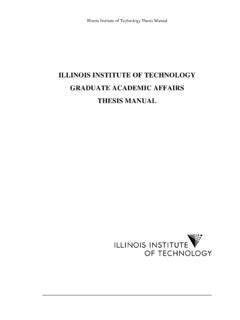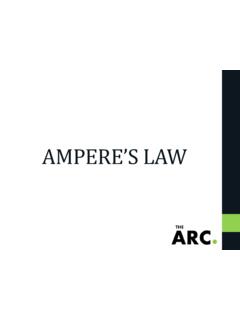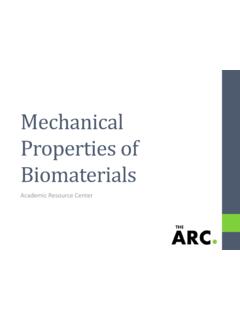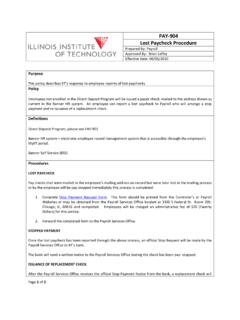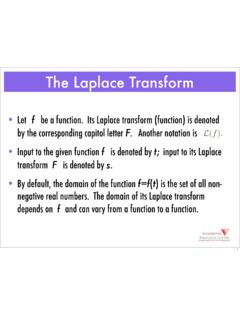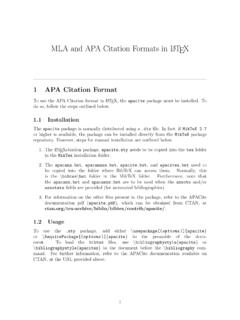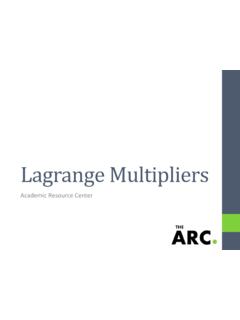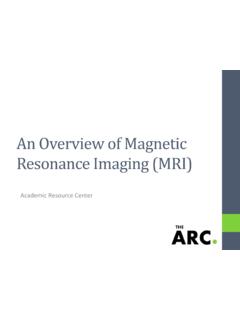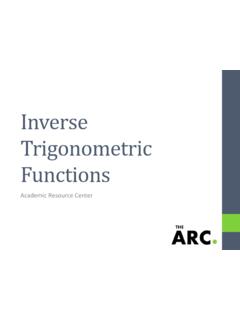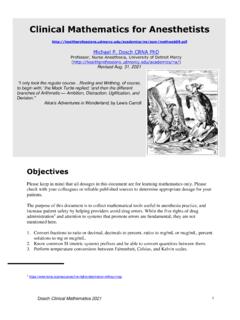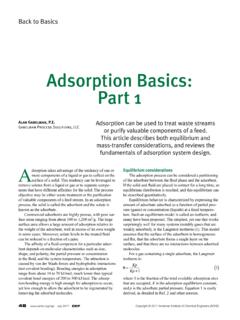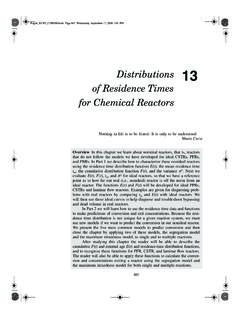Transcription of Thermodynamic Properties and calculation
1 Thermodynamic Properties AND calculation Academic Resource CenterTHERMODYNAMICPROPERTIESA quantity which is either an attribute of an entire system or is a function of position which is continuous and does not vary rapidly over microscopic distances, except possibly for abrupt changes at boundaries between phases of the system; examples are temperature, pressure, volume, concentration, surface tension, and viscosity. Also known as macroscopic CONCEPTS-1 First Law of Thermodynamic : Although energy assumes many forms, the total quantity of energy is constant, and when energy disappears in one form it appears simultaneously in other forms. (Energy of the system) + (Energy of surroundings) = 0 Ut = Q+ W (nU) = Q+ W dUt = dQ+ dW d(nU) = dQ+ dW There exists a form of energy, known as internal energy CONCEPTS-2 PV diagram Virial Equations of StatePV = a + bP + cP2+.
2 ideal gas: Z=1 or PV = RT Van Der Waals Equation of StateFor ideal Gas: Equation for CalculationHeat capacity:dQ + dW = CvdTdW = PdVdQ = CvdT + PdVLet V=RT/P :BASIC CONCEPTS-3 Statements of the Second Law: Statement 1: No apparatus can operate in such a way that its only effect (in system and surroundings) is to convert heat absorbed by a system completely into work done by the system. Statement 2: No process is possible which consists solely in the transfer of heat from one temperature level to a higher onePRIMARY Thermodynamic Properties P, V, T, S & U Combining the first and second laws in reversible process The only requirements are that the system be closed and that the change occur between equilibrium states. H = U + PV A = U TS G = H TSd(nU) = Td(nS) Pd(nV)d(nH) = Td(nS) + (nV)dPd(nA) = Pd(nV) (nS)dd(nG) = (nV)dP (nS)dTdU= TdS PdVdH= TdS+ VdPdA= PdV SdTdG= VdP SdTMaxwell s equationEXAMPLE 1 Air at 1 bar and (25 C) is compressed to 5 bar and by two different mechanically reversible processes: (a) Cooling at constant pressure followed by heating at constant volume.
3 (b) Heating at constant volume followed by cooling at constant pressure. Calculate the heat and work requirements and U and H of the air for each path. The following heat capacities for air may be assumed independent of temperature:CV= and CP= J mol-1K-1 Assume also for air that PV/T is a constant, regardless of the changes it undergoes. At and 1 bar the molar volume of air is : In suche case take the system as 1 mol of air contained in an imaginary piston/cyclinder arrangement. Since the processes considered are mechanically reversible, the piston is imagined to move in the cylinder withour friction. The final volume is (a) During the first step the air is cooled at the constant pressure of 1 bar until the final volume of m3is reached. The temperature of the air at the end of this cooling step is:SOLUTIONS Also, During the second step the volume is held constant at while the air is heated to its final state.
4 The complete process represents the sum of its steps. Hence, Q = -6,941 + 4,958 = -1,938J U = -4,958 + 4,958 = 0J Since the first law applies to the entire process, , and therefore, 0 = -1,983 + WW = 1,983J = = = 6,941 1 105 = 4,958J SOLUTIONS , also applies to the entire process. But and therefore, Hence , and SOLUTIONS Two different steps are used in this case to reach the same final state of the air. In the first step the air is heated at a constant volume equal to its initial valve until the final pressure of 5 bar is reached. The air temperature at the end of this step is: For this step the volume is constant, and During the second step the air is cooled at the constant pressure of 5 bar to its final state:SOLUTIONS Also, For the two steps combined, Q =24,788-34,703 = -9,915J U =24,788-24,788=0J and as before During the second step the volume is held constant at V2 while the air is heated to its final state.
5 The property changes and calculated for the given change in state are the same for both paths. On the other hand the answers to parts (a) and (b) show that Q and W depend on the path. = = = 34,703 5 105 = 24,788J EXAMPLE 2 Air is compressed from an initial condition of 1 bar and 25 Cto a final state of 5 bar and 25 Cby three different mechanically reversible processes in a closed system: (a) Heating at constant volume followed by cooling at constant pressure. (b) Isothermal compression. (c)Adiabatic compression followed by cooling at constant volume. Assume air to be an ideal gas with the constant heat capacities, CV= (5/2)R and CP = (7/2)R. Calculate the work required, heat transferred, and the changes in internal energy and enthalpy of the air for each Choose the system as 1 mol of air, contained in an imaginary frictionless piston/cylinder arrangement.
6 For R= J mol-1K-1,CV= CP= mol-1K-1 The initial and final conditions of the air are identical with those of , where the molar volumes are given as:V1= V2= Moreover, since the initial and final temperatures are the same, then for all parts of the problem:SOLUTIONS (a) The heat transferred, from (b) is Q= Thus by the first law applied to the entire process: (b) Equation for the isothermal compression of an ideal gas applies here: (c) The intial adiabatic compression of the air takes it to its final volume of The temperature and pressure at this point are:SOLUTIONST2=T1 V1V2 1= ( ) P2=P1 V1V2 = 1 ( ) For this step Q=0, and W=CV T= =5,600J For the second step at constant V, W=0. For the overall process, W=5,600+0=5,600J SOLUTIONS Moreover, , and by the first law, Although the property changes and are zero for each process, Q and W are path-dependent.
7 Since the work for each of these mechanically reversible processes is given by , the work for each process is proportional to the total area below the paths on the PV diagram representing the process. The relative sizes of these areas correspond to the numerical values of W. Q= =0 5,600= 5,600J EXAMPLE 3 Determine the enthalpy and entropy changes of liquid water for a change of state from 1 bar and 25 Cto 1,000 bar and 50 C. The following data for water are availbale:t/ CP/barCP/J mol-1K-1V/cm3mol-1 10-6251, 10-6501, 10-6 KEYSSOLUTIONS For application to the change of state described, equations require integration. Since enthalpy and entropy are state functions, the path of integration is arbitrary. Since the data indicate that CPis a weak function of T and that both V and are weak functions of P, integration with arithmetic means is satisfactory.
8 The integrated forms of Eqs that result are:SOLUTIONS For P=1 bar, and for t=50 CSOLUTIONS Substitution of these numerical values into the equation for gives: Similarly for , Note that the effect of a pressure change of almost 1,000 bar on the enthalpy and entropy of liquid water is less than that of a temperature change of only 25 C H= + 1 513 10 6 (1,000 1)10cm3bar J 1 S= 513 10 6 (1,000 1)10cm3bar J 1 THERMODYNAMICPROPERTIESANDTHEIRCHARACTER ISTICS
